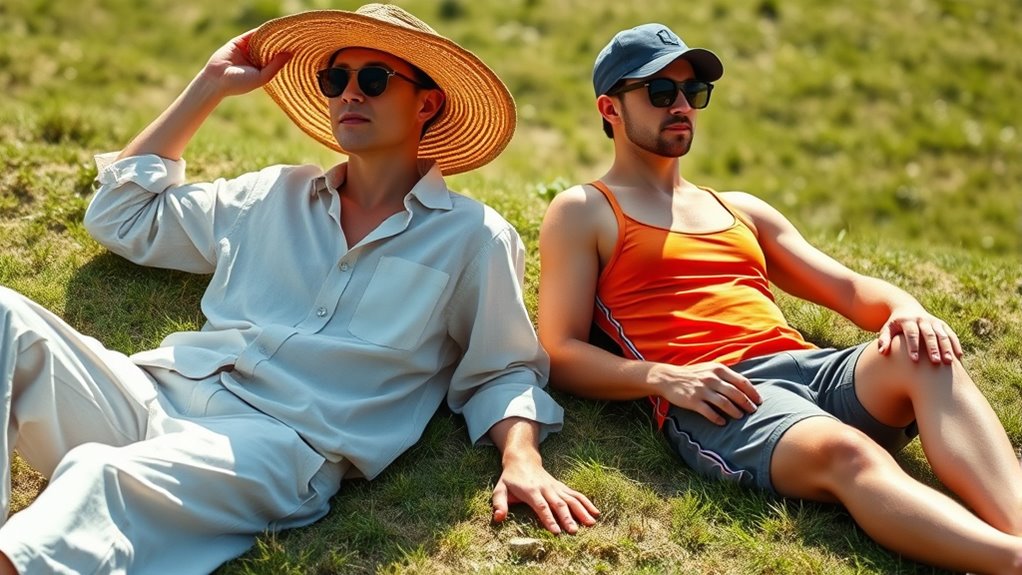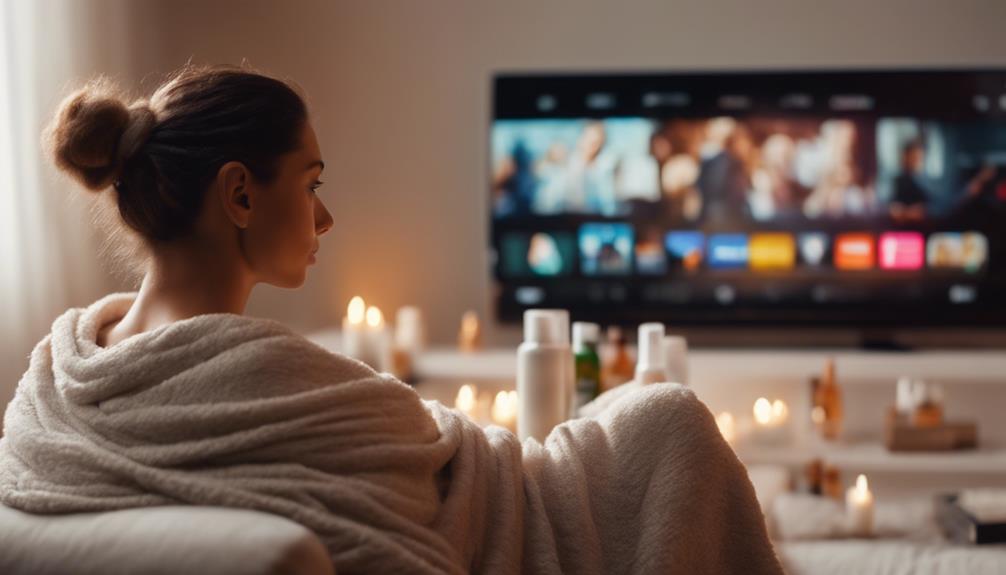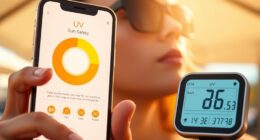Your clothing choices considerably impact your tanning risk by either blocking or allowing UV rays to reach your skin. Wearing tightly woven, UPF-rated fabrics, especially in darker colors, provides better protection and reduces tanning chances. Layering long sleeves and full-length pants adds extra shielding during peak sunlight hours. If you opt for lighter, loose-weave fabrics or minimal coverage, you’re more exposed to UV rays. Keep exploring to discover how to further minimize your tanning risk effectively.
Key Takeaways
- Tightly woven, UPF-rated fabrics offer better protection, reducing UV exposure and tanning risk.
- Dark-colored clothing absorbs more UV rays, providing increased tanning protection compared to lighter shades.
- Covering skin with long sleeves and full-length pants minimizes UV penetration and tanning chances.
- Choosing breathable, UV-blocking clothing allows outdoor activity while limiting skin exposure.
- Layering clothing enhances UV barrier, decreasing the likelihood of tanning and skin damage.

Choosing the right clothing when you’re outdoors can profoundly impact your risk of harmful sun exposure. Your clothing acts as a barrier between your skin and the sun’s rays, directly influencing how much UV exposure you receive. Not all fabrics are created equal, and selecting the right clothing materials can make a significant difference in protecting your skin. Light, breathable fabrics like cotton or linen can provide some defense, but they often leave gaps that let UV rays penetrate. On the other hand, tightly woven fabrics, regardless of their lightweight feel, tend to block more UV rays, reducing your risk of sun damage. When shopping for outdoor clothing, look for options labeled with UPF (Ultraviolet Protection Factor). These fabrics are specially designed to shield your skin from UV rays more effectively than regular clothing. Wearing UPF-rated clothing means you’re actively reducing your UV exposure without relying solely on sunscreen, especially during prolonged outdoor activities. Additionally, clothing’s fabric weave plays a crucial role in how well the material protects against UV rays, emphasizing the importance of choosing tightly woven fabrics for optimal sun safety.
In addition to choosing the right materials, the color of your clothing plays a role. Darker shades tend to absorb more UV rays, offering better protection, while lighter colors reflect sunlight, which can also help keep you cooler but may offer slightly less sun protection. However, the most critical factor remains the fabric’s weave and composition. Thin, loose-weave materials, even if they are dark or light-colored, might not provide enough coverage, so opt for tightly woven fabrics for maximum protection. When you plan outdoor activities, consider layering your clothing with long sleeves and full-length pants. This extra coverage acts as a physical shield against UV rays, especially during peak sunlight hours when UV exposure is at its highest.
Frequently Asked Questions
Can Wearing Sunscreen Under Clothing Improve Protection?
Yes, wearing sunscreen under clothing can improve protection through sunscreen layering, especially if your clothing material isn’t tightly woven or offers limited UV coverage. Applying sunscreen underneath clothes creates an extra barrier, reducing UV exposure. Opt for lightweight, tightly woven fabrics for better protection, and consider applying sunscreen to areas that might be exposed or where clothing doesn’t fully cover. This combined approach helps prevent tanning and sun damage effectively.
How Does Clothing Color Influence UV Exposure?
Color can cause clothing to catch or repel UV rays. Darker hues absorb more UV radiation, giving you less sun exposure and reducing tanning risk. Lighter shades reflect UV rays, which might increase exposure slightly. Your clothing material and color contrast also matter—denser, tightly woven fabrics block more UV than loose, lightweight ones. So, choosing dark, dense fabrics minimizes UV penetration, keeping your skin safer from harmful rays.
Are There Fabrics That Block More UV Rays?
Yes, certain fabrics block more UV rays. Look for UV blocking fabrics made with tightly woven material, as fabric weave density plays a vital role in protection. Thicker, densely woven fabrics like polyester and nylon offer better UV defense than lightweight, loose weaves. When choosing clothing, check for UPF ratings to guarantee maximum coverage, especially if you’ll be exposed to strong sunlight for extended periods.
Does Clothing Fit Affect UV Protection Effectiveness?
Yes, clothing fit affects UV protection effectiveness. If your clothes are too tight, they may stretch, exposing more skin and reducing their protective barrier. Loose-fitting clothes offer better coverage and allow fabric to lay flat, maximizing UV blocking. Additionally, fabric breathability influences comfort but not UV protection directly. Choose well-fitting, tightly woven fabrics for ideal UV defense, especially during prolonged sun exposure.
How Often Should I Replace Clothing for UV Protection?
Think of your UV-protective clothing as a delicate garden that needs regular tending. You should replace your clothing every 2 to 3 years, or sooner if it shows signs of wear like fading, fraying, or thinning. Proper clothing maintenance maintains the fabric’s UV protection intact, extending its lifespan. Over time, UV fabric’s effectiveness diminishes, so staying vigilant guarantees you’re always shielded from harmful rays.
Conclusion
Remember, your clothing choices really impact your tanning risk. Wearing more coverage can lower your chances of sunburn and skin damage. Did you know that people who wear protective clothing are 50% less likely to develop skin issues? So, next time you head outdoors, opt for long sleeves and hats. It’s a simple step that can make a big difference in keeping your skin healthy and safe from harmful UV rays.









